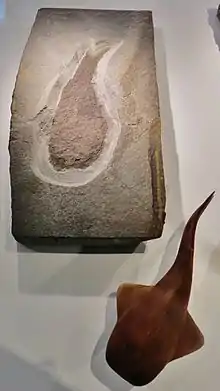Loganellia
Loganellia is a genus of jawless fish which lived between 430-370 million years ago, during the Silurian and Devonian periods of the Paleozoic.[1] Loganellia belonged to the Thelodonti class and like other Thelodonts possessed scales instead of plate armor.
| Loganellia | |
|---|---|
 | |
| Loganellia scotica (Fossil and model, Museum am Löwentor, Stuttgart) | |
| Scientific classification | |
| Kingdom: | Animalia |
| Phylum: | Chordata |
| Superclass: | Agnatha |
| Order: | †Loganelliformes |
| Family: | †Loganelliidae |
| Genus: | †Loganellia Fredholm, 1990 |
| Type species | |
| †Loganellia scotica (Traquair, 1898) | |
| Species | |
| |
Loganellia are thought to be more closely related to the crown group of gnathostomes than conodonts. They are noted for their denticle whorls - oropharyngeal denticles that lined their branchial bars - which are thought to be homologous with other, later gnathostome teeth. In this sense, Loganellia may possess the earliest known dental structures related to modern teeth, and would have evolved in the throat, rather than through dermal denticles or jaws.[1]
 Fossil |
 Loganellia, swimming in a shallow sea 400 million years ago. |
 Loganellia scotica (Traquair, 1898), drawn by Traquair[2] |
References
- Ungar, Peter (2010). Mammal Teeth: Origin, Evolution and Diversity. Baltimore: Johns Hopkins University Press. p. 77.
- Goodrich, E.S. (1964) [1909]. "Vertebrata Craniata". In Lankester, Ray (ed.). A Treatise on Zoology. IX. Amsterdam: Asher. p. 197. Includes illustrations by Traquair.
This article is issued from Wikipedia. The text is licensed under Creative Commons - Attribution - Sharealike. Additional terms may apply for the media files.